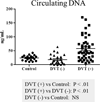Plasma DNA is Elevated in Patients with Deep Vein Thrombosis
- PMID: 24187669
- PMCID: PMC3810974
- DOI: 10.1016/j.jvsv.2012.12.002
Plasma DNA is Elevated in Patients with Deep Vein Thrombosis
Abstract
Objective: To investigate if plasma DNA is elevated in patients with deep vein thrombosis (DVT) and to determine whether there is a correlation with other biomarkers of DVT.
Background: Leukocytes release DNA to form extracellular traps (ETs), which have recently been linked to experimental DVT. In baboons and mice, extracellular DNA co-localized with von Willebrand factor (VWF) in the thrombus and DNA appeared in circulation at the time of thrombus formation. ETs have not been associated with clinical DVT.
Setting: From December 2008 to August 2010, patients were screened through the University of Michigan Diagnostic Vascular Unit and were divided into three distinct groups: 1) the DVT positive group, consisting of patients who were symptomatic for DVT, which was confirmed by compression duplex ultrasound (n=47); 2) the DVT negative group, consisting of patients that present with swelling and leg pain but had a negative compression duplex ultrasound, (n=28); and 3) a control group of healthy non-pregnant volunteers without signs or symptoms of active or previous DVT (n=19). Patients were excluded if they were less than 18 years of age, unwillingness to consent, pregnant, on an anticoagulant therapy, or diagnosed with isolated calf vein thrombosis.
Methods: Blood was collected for circulating DNA, CRP, D-dimer, VWF activity, myeloperoxidase (MPO), ADAMTS13 and VWF. The Wells score for a patient's risk of DVT was assessed. The Receiver Operating Characteristic (ROC) curve was generated to determine the strength of the relationship between circulating DNA levels and the presence of DVT. A Spearman correlation was performed to determine the relationship between the DNA levels and the biomarkers and the Wells score. Additionally the ratio of ADAMTS13/VWF was assessed.
Results: Our results showed that circulating DNA (a surrogate marker for NETs) was significantly elevated in DVT patients, compared to both DVT negative patients (57.7±6.3 vs. 17.9±3.5ng/mL, P<.01) and controls (57.7±6.3 vs. 23.9±2.1ng/mL, P<.01). There was a strong positive correlation with CRP (P<.01), D-dimer (P<.01), VWF (P<.01), Wells score (P<.01) and myeloperoxidase (MPO) (P<.01), along with a strong negative correlation with ADAMTS13 (P<.01) and the ADAMTS13/VWF ratio. The logistic regression model showed a strong association between plasma DNA and the presence of DVT (ROC curve was determined to be 0.814).
Conclusions: Plasma DNA is elevated in patients with deep vein thrombosis and correlates with biomarkers of DVT. A strong correlation between circulating DNA and MPO suggests that neutrophils may be a source of plasma DNA in patients with DVT.
Figures




Similar articles
-
ADAMTS13 activity, high VWF and FVIII levels in the pathogenesis of deep vein thrombosis.Thromb Res. 2021 Jan;197:132-137. doi: 10.1016/j.thromres.2020.10.037. Epub 2020 Nov 7. Thromb Res. 2021. PMID: 33212380
-
Role of ADAMTS13, VWF and F8 genes in deep vein thrombosis.PLoS One. 2021 Oct 18;16(10):e0258675. doi: 10.1371/journal.pone.0258675. eCollection 2021. PLoS One. 2021. PMID: 34662354 Free PMC article.
-
Polymorphisms and mutations in vWF and ADAMTS13 genes and their correlation with plasma levels of FVIII and vWF in patients with deep venous thrombosis.Clin Appl Thromb Hemost. 2011 Oct;17(5):514-8. doi: 10.1177/1076029610375815. Epub 2010 Aug 3. Clin Appl Thromb Hemost. 2011. PMID: 20682599 Clinical Trial.
-
Duplex ultrasound, clinical score, thrombotic risk, and D-dimer testing for evidence based diagnosis and management of deep vein thrombosis and alternative diagnoses in the primary care setting and outpatient ward.Int Angiol. 2014 Feb;33(1):1-19. Int Angiol. 2014. PMID: 24452081 Review.
-
[Clinical features of patients with venous thromboembolism: 177 case analysis in 10 years].Zhonghua Wei Zhong Bing Ji Jiu Yi Xue. 2019 Apr;31(4):453-457. doi: 10.3760/cma.j.issn.2095-4352.2019.04.016. Zhonghua Wei Zhong Bing Ji Jiu Yi Xue. 2019. PMID: 31109420 Review. Chinese.
Cited by
-
Red Blood Cell Contribution to Thrombosis in Polycythemia Vera and Essential Thrombocythemia.Int J Mol Sci. 2024 Jan 24;25(3):1417. doi: 10.3390/ijms25031417. Int J Mol Sci. 2024. PMID: 38338695 Free PMC article. Review.
-
Increased inflammation and endothelial markers in patients with late severe post-thrombotic syndrome.PLoS One. 2020 Jan 16;15(1):e0227150. doi: 10.1371/journal.pone.0227150. eCollection 2020. PLoS One. 2020. PMID: 31945777 Free PMC article.
-
The effect of neutrophil extracellular traps in venous thrombosis.Thromb J. 2023 Jun 16;21(1):67. doi: 10.1186/s12959-023-00512-4. Thromb J. 2023. PMID: 37328882 Free PMC article. Review.
-
Fibrinogen and Fibrin in Hemostasis and Thrombosis.Arterioscler Thromb Vasc Biol. 2017 Mar;37(3):e13-e21. doi: 10.1161/ATVBAHA.117.308564. Arterioscler Thromb Vasc Biol. 2017. PMID: 28228446 Free PMC article. Review. No abstract available.
-
Is Infection an Independent Risk Factor for Venous Thromboembolism? A Population-Based, Case-Control Study.Am J Med. 2018 Mar;131(3):307-316.e2. doi: 10.1016/j.amjmed.2017.09.015. Epub 2017 Oct 4. Am J Med. 2018. PMID: 28987552 Free PMC article.
References
-
- Brinkmann V, Reichard U, Goosmann C, Fauler B, Uhlemann Y, Weiss DS, et al. Neutrophil extracellular traps kill bacteria. Science. 2004 Mar 5;303(5663):1532–1535. - PubMed
-
- von Kockritz-Blickwede M, Goldmann O, Thulin P, Heinemann K, Norrby-Teglund A, Rohde M, et al. Phagocytosis-independent antimicrobial activity of mast cells by means of extracellular trap formation. Blood. 2008 Mar 15;111(6):3070–3080. - PubMed
-
- Yousefi S, Gold JA, Andina N, Lee JJ, Kelly AM, Kozlowski E, et al. Catapult-like release of mitochondrial DNA by eosinophils contributes to antibacterial defense. Nat Med. 2008 Sep;14(9):949–953. - PubMed
Grants and funding
LinkOut - more resources
Full Text Sources
Other Literature Sources
Research Materials
Miscellaneous

